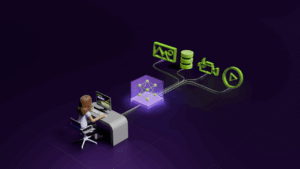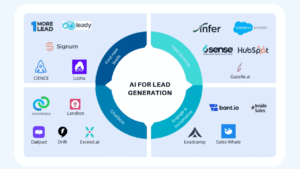The race to build truly autonomous AI agents has taken a major leap forward with Manus AI, a revolutionary system designed to plan, execute, and optimize complex tasks without continuous human intervention. Developed by the Chinese startup Monica, Manus AI is not just another language model—it’s an autonomous execution agent, a concept that traditional AI models like GPT-4 and Claude 3.5 have yet to master.
While DeepSeek, another leading Chinese AI, has demonstrated the ability to match Western AI powerhouses in language processing, Manus AI moves beyond replication—it innovates. By leveraging a multi-agent framework, adaptive model selection, and asynchronous task execution, Manus operates independently, reducing reliance on human input. This positions it closer to Artificial General Intelligence (AGI)—a concept where machines exhibit human-like adaptability across diverse functions.
Its performance benchmarks in GAIA tests further validate its superiority where it spectacularly outperformed most of its major competitors. More significantly, Manus AI was able to achieve this with dramatically lower costs, making it 15–30x cheaper than alternatives like GPT-4 and Claude 3.5 Sonnet.
So, without further ado, let’s dive in and uncover how Manus AI is revolutionizing AI-driven productivity and decision-making, setting new benchmarks and reshaping the future of autonomous intelligence.
Performance Benchmarks and Efficiency
As discussed above, Manus AI isn’t just another autonomous agent—it’s setting new standards in the world of AI efficiency. In GAIA benchmark tests, a widely recognized metric for real-world problem-solving, Manus AI outperformed major competitors, scoring 86.5% on basic tasks, 70.1% on intermediate challenges, and 57.7% on complex problems. These numbers place it ahead of OpenAI’s Deep Research system, signaling its superior ability to break down, analyze, and execute multi-step tasks with greater accuracy and reliability.
What truly sets Manus apart is its efficiency-first design. Unlike compute-heavy models that demand extensive GPU resources, Manus AI optimizes workloads dynamically, reducing computational overhead while maintaining high performance. This not only lowers infrastructure costs but also minimizes energy consumption, making it a cost-effective and environmentally sustainable alternative.
Smaller businesses and independent developers, who often struggle with the high costs of AI adoption, can now leverage Manus without needing enterprise-scale infrastructure—a competitive edge few rivals offer.
Thus, by merging speed, cost-efficiency, and task versatility, Manus AI is redefining what AI-driven automation should look like in real-world applications.
Technical Architecture and Training Methodology
In an era where AI models are competing not just on intelligence but on efficiency and adaptability, Manus AI stands out with its sophisticated multi-agent framework, adaptive language model selection, and seamless cloud-based operations. Unlike conventional AI models that often struggle with complex, multi-step tasks, Manus is designed to work autonomously, intelligently delegating work to specialized agents, ensuring both speed and accuracy.
Modular Multi-Agent Framework: Precision Through Specialization
Most AI models operate in a monolithic structure, where a single system handles everything—leading to inefficiencies and suboptimal performance when managing intricate tasks. Manus AI, however, reimagines this process with a multi-agent architecture, where each agent is assigned a distinct role, mirroring how human teams divide work.
Consider a real-world scenario: planning an international business trip. One agent within Manus scans flight options, another analyzes visa requirements, a third compares hotels, and yet another creates an optimized itinerary based on user preferences. Rather than running through these tasks sequentially, these agents work simultaneously, drastically reducing response time. This parallelized execution model makes Manus significantly faster and more efficient than AI models operating in a linear sequence.
Adaptive Integration of Large Language Models: Choosing the Right Brain for the Job
One of Manus AI’s greatest advantages is that it doesn’t rely on a single large language model (LLM) like many of its competitors. Instead, it is trained to intelligently select the best model for the task at hand. Whether it’s Claude 3.5 Sonnet for logical reasoning and structured outputs, Alibaba’s Qwen for language translation, or another specialized model for data analytics—Manus makes real-time selections based on the complexity and nature of the task.
This means that Manus doesn’t just “guess” like some AI models—it optimizes performance dynamically, reducing computational load without sacrificing accuracy. This is particularly crucial for businesses and enterprises, where efficiency directly impacts operational costs.
Asynchronous Cloud-Based Operations: AI That Works While You Don’t
A common challenge with AI-driven automation is that most models require active engagement—meaning users have to be present and feeding inputs for processes to move forward. Manus eliminates this friction with its asynchronous cloud-based framework, allowing it to work in the background, even when the user is offline.
Imagine delegating a task before leaving for a meeting—by the time you return, the AI has already finished the research, analysis, or report generation, without requiring constant check-ins. This level of autonomy is what makes Manus AI truly scalable and practical for real-world applications, making it an invaluable asset for enterprises seeking AI-driven efficiency.
Cost Efficiency and Computational Requirements
One of Manus AI’s notable advantages is its cost-effectiveness. Its architecture is meticulously engineered to minimize computational demands without compromising performance. This optimization translates to reduced infrastructure costs and a smaller environmental footprint, making it an attractive option for businesses of all sizes, including smaller enterprises and individual developers.
When we evaluate the cost structures of leading AI agents currently ruling the market, Manus AI’s affordability becomes quite evident. Let’s look at some of its competitors and compare them on the basis of cost-effectiveness and affordability.
| AI Model | Estimated Cost per 1M Tokens | Computational Efficiency | Affordability |
| Manus AI | ~$2 | Highly optimized, low resource consumption | Most cost-effective option |
| OpenAI’s GPT-4 | $30 (prompt) / $60 (completion) | High resource demand, extensive GPU usage | Higher operational costs due to computational intensity |
| Anthropic’s Claude 3.5 Sonnet | $3,000 (input) / $15,000 (output) | Optimized for performance with moderate resource usage | More affordable compared to GPT-4 for input but costly for output |
*Note: The cost is calculated based on the pricing information available from the respective providers and is only an estimated number.
Key Takeaways:
- Manus AI is up to 15–30x cheaper than GPT-4 for equivalent token usage.
- Claude 3.5 Sonnet has a significant cost gap between input and output, making it expensive for tasks requiring long responses.
- OpenAI’s GPT-4 remains costly, making it a high-end option suited for tasks where quality outweighs expense.
- Manus AI’s efficient processing significantly reduces infrastructure costs, making it an ideal choice for startups, SMBs, and budget-conscious enterprises.
Thus, this comparison highlights Manus AI’s cost-effectiveness, making it an attractive choice for businesses seeking efficient AI solutions without incurring high operational expenses.
Manus AI Comparative Analysis with Major Competitors
Building upon the previous cost comparison, it’s essential to also evaluate Manus AI against its competitors across other critical dimensions: specialization, user experience, and data privacy. So, let’s dive in.
| Comparison Area | Manus AI | OpenAI’s GPT-4 | Anthropic’s Claude 3.5 Sonnet |
| Specialization | Tailored for niche applications, offering industry-specific solutions for targeted sectors. | General-purpose model with broad versatility but may require customization for industry-specific tasks. | Prioritizes safety and ethical AI use, but primarily focused on textual interactions. |
| User Experience | Intuitive interface designed for non-technical users, ensuring ease of use and seamless integration. | Advanced functionalities but requires technical expertise for integration and optimal use. | User-friendly and safe, but its limited multimodal capabilities may reduce versatility. |
| Data Privacy | Enhanced data privacy assurances, particularly appealing for organizations with stringent compliance needs. | Implements security measures but may be subject to broader data collection due to OpenAI’s scale. | Opt-in data usage policy provides users with greater control over data privacy. |
| Response Accuracy | Optimized for structured and well-defined tasks, delivering high accuracy in specific applications. | Excels in reasoning and creative text generation but may produce inconsistencies in factual outputs. | Performs well in structured environments but may struggle with nuanced, high-complexity tasks. |
| Scalability & Enterprise Adoption | Designed for efficiency, allowing businesses to scale without excessive computational costs. | Well-suited for enterprise solutions but demands significant infrastructure resources for scaling. | Gains traction in ethical AI adoption, but scalability in high-demand enterprise settings remains a challenge. |
So, the above comparisons clearly reflect how Manus AI stands out for its cost efficiency, industry-specific specialization, and intuitive user experience, making it an ideal choice for businesses seeking affordable and streamlined AI solutions.
While GPT-4 offers versatility and strong reasoning capabilities, it demands higher infrastructure costs and technical expertise. Claude 3.5 Sonnet focuses on safety and privacy, but its limited multimodal capabilities and scalability challenges may restrict its enterprise adoption. Ultimately, Manus AI provides the best balance of affordability, efficiency, and ease of use for organizations looking for tailored AI-driven automation.
Manus AI Real-World Applications and Performance
Manus AI’s versatility is exemplified through its autonomous handling of various complex tasks, significantly enhancing efficiency across multiple domains. Some of these include:
- Resume Screening: Enhancing Recruitment Efficiency in SMBs
In the recruitment landscape, Manus AI automates the traditionally labor-intensive process of resume screening:
- Automated Document Processing: Manus AI autonomously unzips compressed files containing multiple resumes and meticulously reviews each document page by page.
- Structured Data Compilation: It extracts pertinent details such as educational background, work experience, and skill sets, organizing this information into structured formats like spreadsheets.
- Candidate Ranking: By analyzing specific expertise areas, such as reinforcement learning, Manus AI ranks candidates, providing a prioritized list that aids recruiters in making informed decisions.
This automation not only accelerates the hiring process but also minimizes human biases, ensuring a more objective evaluation of applicants.
- Apartment Hunting: Personalized Real Estate Solutions
Manus AI transforms the apartment hunting experience by tailoring searches to individual preferences:
- Comprehensive Data Analysis: It evaluates various factors, including crime statistics, rental market trends, and weather conditions, to assess neighborhood suitability.
- Budget-Conscious Recommendations: By analyzing financial data, Manus AI identifies properties that align with the user’s budget constraints, ensuring affordability.
- Detailed Reporting: The AI compiles its findings into comprehensive reports, offering users a clear understanding of potential living environments.
This personalized approach simplifies the decision-making process for prospective renters or buyers, aligning property options with their specific needs and preferences.
- Stock Analysis: Empowering Investors with Data-Driven Insights
In the financial sector, Manus AI serves as a powerful tool for investors seeking in-depth market analysis:
- Autonomous Research: It scans financial reports and swiftly provides summaries, enabling investors to grasp essential information without sifting through extensive documents.
- Rapid Data Processing: Capable of analyzing large datasets in seconds, Manus AI identifies correlations and trends that might be overlooked manually.
- User-Friendly Interface: Investors can interact with Manus AI through a conversational interface, posing questions and receiving structured, actionable responses.
By delivering these capabilities, Manus AI empowers investors to make informed decisions swiftly, enhancing their ability to respond to market dynamics effectively.
Comparative Analysis: Manus AI vs. DeepSeek
The emergence of Manus AI has also naturally sparked notable comparisons with DeepSeek, another prominent Chinese AI model. While DeepSeek showcased China’s capability to replicate Western AI advancements, Manus AI represents a significant leap forward, pushing the boundaries of AI autonomy. Experts highlight that Manus’s sophisticated architecture and autonomous functionalities position it beyond DeepSeek’s achievements, signaling a pivotal shift in AI development.
Core Technical Architectures:
- DeepSeek: Built on a hybrid expert model (MoE) with 671 billion parameters, DeepSeek focuses on optimizing language processing and knowledge integration. Its strength lies in deep semantic understanding, logical reasoning, and high-quality text generation, such as drafting legal contracts or academic papers.
- Manus AI: Employs a multi-agent architecture that operates within virtual machines. It integrates tools like browsers and code editors to autonomously execute tasks, such as generating reports or analyzing stocks. This design enables Manus to plan, execute, and refine tasks independently, reducing the need for constant supervision.
Application Scenarios:
- DeepSeek: Ideal for knowledge-intensive tasks, including legal document refinement, academic writing, and mathematical problem-solving. It is also utilized in government and enterprise applications, such as industrial robot instruction generation or administrative workflow automation.
- Manus AI: Optimized for execution-heavy workflows, such as resume screening, financial analysis, and real estate research. It autonomously handles coding and testing, making it suitable for creative tasks like game development or webpage design.
Market Positioning and User Value:
- DeepSeek: Acts as a “super brain” for enterprises, offering affordable, scalable AI infrastructure. Its open-source model and integration with platforms like Alibaba Cloud make it a cost-effective choice for small and medium-sized enterprises (SMEs).
- Manus AI: Positioned as a “digital employee” for enterprises, targeting industries like finance and healthcare. Its “turnkey” solutions reduce manual intervention, boosting efficiency by up to 600% in tasks like financial reporting.
Challenges and Future Directions:
- DeepSeek: Struggles with knowledge-update delays and limited multimodal capabilities. Future development hinges on enhancing visual processing and leveraging its open-source community for iterative improvements.
- Manus AI: Faces risks like error propagation in automated workflows and high computational costs. Its sustainability depends on optimizing token consumption and refining error-handling mechanisms.
While DeepSeek excels as a knowledge processor, Manus AI thrives as a task executor. Their coexistence reflects the diversification of AI applications, with users choosing based on specific needs: DeepSeek for deep thinking and content creation, and Manus for automation and cross-platform efficiency. In the coming years, we may see convergence where integrated systems leverage DeepSeek’s intelligence and Manus’s operational prowess, pushing AI toward more practical and human-centric solutions.
The Future of AI and What It Means for Businesses
The rise of Manus AI signals a new era in AI innovation, intensifying discussions about China’s role in the global AI race. While Western AI giants have dominated the landscape, Manus AI demonstrates that autonomous AI agents are the next frontier—capable of executing complex tasks with minimal human intervention.
However, privacy and security concerns remain critical. As AI agents become more autonomous, businesses must prioritize secure data management and evaluate AI transparency before integration. Additionally, the economic impact of AI automation is undeniable—industries that rely on repetitive tasks will see workforce shifts, urging organizations to invest in AI literacy and strategic workforce planning to stay competitive.
So, what should be your next steps?
- Evaluate AI Autonomy Needs – Businesses should identify which processes can benefit from AI-driven automation without compromising control.
- Strengthen AI Governance – Establish data security policies to ensure compliance when integrating autonomous agents.
- Upskill Workforce for AI Collaboration – AI isn’t replacing jobs but transforming them. Equip employees with AI skills to enhance productivity.
At Tech-Transformation, we decode cutting-edge AI trends and deliver insights that empower businesses like yours to navigate the AI revolution. Want to stay ahead of the curve—get in touch today for deep, actionable AI strategies that can drive real impact for your enterprise.









